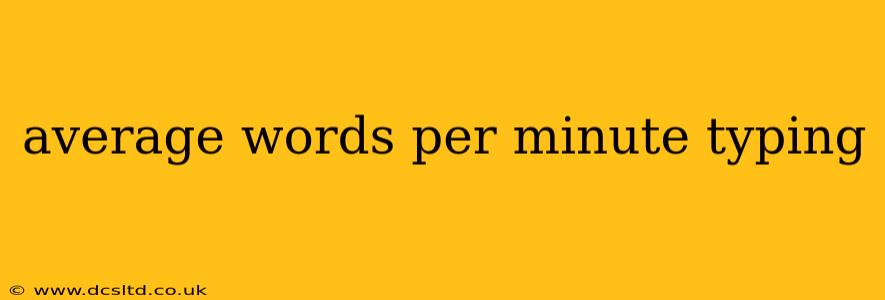Typing speed, measured in words per minute (WPM), is a crucial skill in today's digital world. Whether you're a student, professional, or simply someone who spends a lot of time on a keyboard, knowing your WPM and how to improve it can significantly boost your productivity and efficiency. This guide delves into the average WPM, factors influencing typing speed, and methods to improve your typing skills.
What is the Average Words Per Minute Typing Speed?
The average typing speed varies considerably depending on factors like age, experience, and typing method. However, a general consensus places the average WPM for adults somewhere between 40 and 60 words per minute. Beginners might type much slower, while experienced typists can achieve significantly higher speeds. Keep in mind that these are averages; many individuals fall outside this range.
How is Typing Speed Calculated?
Typing speed is calculated by dividing the number of words typed correctly by the time taken in minutes. Accuracy is crucial; a fast typing speed with numerous errors is less efficient than a slightly slower speed with high accuracy. Many online typing tests automatically calculate your WPM and accuracy.
Factors Affecting Typing Speed
Several factors influence an individual's typing speed:
- Experience: Years of practice significantly impact typing speed. Consistent typing practice gradually increases speed and accuracy.
- Typing Technique: Proper posture, finger placement (using all ten fingers), and efficient keystrokes are paramount. Poor technique can hinder speed and lead to errors.
- Keyboard Familiarity: Comfort and familiarity with a specific keyboard layout significantly influence typing speed.
- Practice and Repetition: Consistent practice and repetition of typing exercises are essential for improvement.
- Age and Cognitive Abilities: Age and cognitive abilities, including hand-eye coordination, can slightly affect typing speed.
- Typing Method: Touch typing (typing without looking at the keyboard) is significantly faster than hunt-and-peck typing.
How Can I Improve My Typing Speed?
Improving your typing speed involves consistent practice and focusing on the right techniques. Here are some effective strategies:
- Practice Regularly: Even short, regular practice sessions are more effective than infrequent, long sessions. Aim for consistency rather than intensity.
- Learn Touch Typing: If you don't already use touch typing, learning it is crucial. Numerous online resources and courses are available to help you master this technique.
- Use Online Typing Tests: Regularly using online typing tests helps you track your progress, identify areas for improvement, and maintain motivation.
- Focus on Accuracy Over Speed: Initially, prioritize accuracy. Speed will naturally increase as accuracy improves.
- Use Ergonomic Keyboards and Posture: Proper posture and an ergonomic keyboard can significantly improve comfort and efficiency.
- Take Breaks: Avoid prolonged typing sessions without breaks. Regular breaks prevent fatigue and maintain focus.
What is a Good Typing Speed?
A "good" typing speed depends on the context. For casual users, a speed of 40-60 WPM is generally considered adequate. However, professionals in fields requiring extensive typing, such as writers or programmers, often aim for much higher speeds—often exceeding 70 WPM.
How Can I Increase My Typing Speed Quickly?
There's no magic bullet for rapidly increasing typing speed. Consistent, focused practice is key. Utilizing online typing tutors, focusing on proper technique, and setting realistic goals contribute to gradual but significant improvements.
What is the Fastest Typing Speed Ever Recorded?
While precise records can be difficult to verify, some typists have reportedly achieved speeds exceeding 200 WPM. These speeds usually involve highly specialized techniques and extensive training.
Conclusion
Improving your typing speed requires dedication and consistent practice. By focusing on proper technique, utilizing available resources, and setting realistic goals, you can significantly increase your WPM and improve your overall productivity. Remember that accuracy is as important as speed—strive for both to maximize efficiency.
